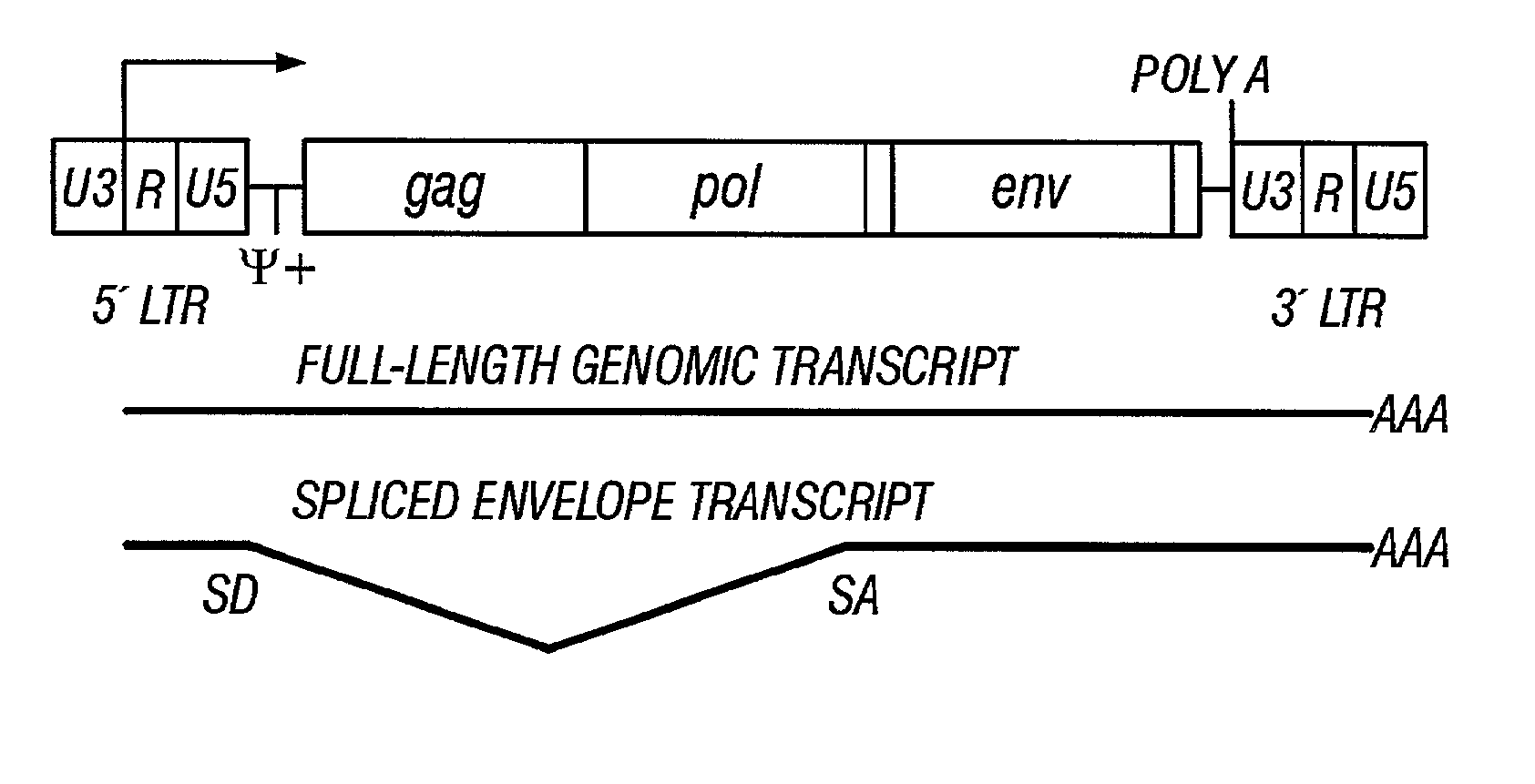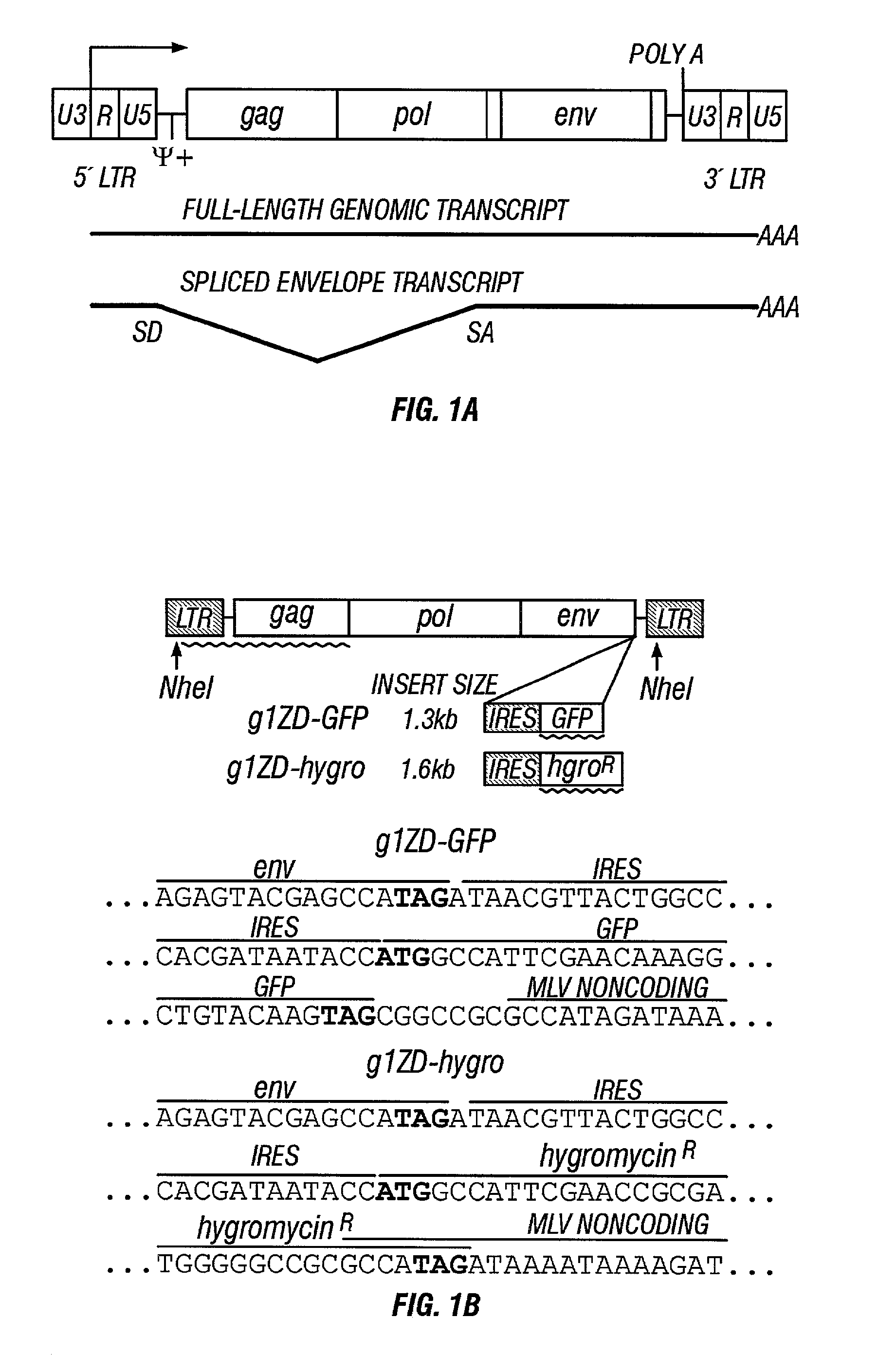Gene delivery system and methods of use
a technology of gene delivery and retrovirus, applied in the field of viral vectors, can solve the problems of insufficient transduction in vivo, vectors are incapable of secondary horizontal infections of adjacent cells, and cannot encapadate their own wild type virus genome, so as to reduce or eliminate the native pathogenic potential of replication-competent retroviruses, improve the specificity of target cells, and efficient in vivo transduction
- Summary
- Abstract
- Description
- Claims
- Application Information
AI Technical Summary
Benefits of technology
Problems solved by technology
Method used
Image
Examples
first embodiment
[0052] In a first embodiment, the invention provides a recombinant retrovirus capable of infecting a non-dividing cell, a dividing cell, or a cell having a cell proliferative disorder. The recombinant replication competent retrovirus of the present invention comprises a polynucleotide sequence having a viral GAG, a viral POL, a viral ENV, a heterologous polynucleotide and one or more targeting polynucleotide sequence for cell- or tissue-specific targeting of the retrovirus to a particular tissue, cell or cell type, as described herein.
[0053] The heterologous nucleic acid sequence is operably linked to a regulatory nucleic acid sequence. As used herein, the term "heterologous" nucleic acid sequence or transgene refers to a sequence that does not normally exist in the wild (e.g., in the wild-type retrovirus) or a sequence that originates from a foreign species, or, if from the same species, it may be substantially modified from its original form. Alternatively, an unchanged nucleic ac...
example 1
[0096] Construction of Replication Competent Retroviruses
[0097] There have been few reports in the literature regarding the stability of insertions in the context of replication-competent MoMLV, and all of these have used insertion positions within the 3' long terminal repeat sequence (LTR). Most of these insertions were deleted within one or two serial passages of the virus. In this case the size and nature of the inserted sequences seemed to have little correlation with the stability of the vector, as small inserts were often deleted just as quickly as larger inserts. One important consideration may be the positioning of the insertion; as the reverse transcription process entails duplication of the U3 region of the 3' LTR (FIG. 1), this may result in decreased stability of non-essential sequences inserted into this position.
[0098] An infectious Mo-MLV proviral clone was excised with NheI from plasmid pZAP and ligated to the plasmid backbone of retroviral vector gIZIN. The IRES of ...
example 2
[0104] Construction of RCR Vectors Targeted to Human Breast Cancer Cells
[0105] Chimeric MoMLV and SNV env sequences which contain targeting moieties directed against human breast cancer cells, and which have proven successful for targeting in previous studies, were utilized. The targeting moiety for MoMLV env was the peptide hormone heregulin, and the targeting moiety for SNV env was the single chain antibody B6.2, originally derived by immunizing mice with a membrane-enriched fraction from a human breast tumor. Using an IRES sequence, either a marker gene (such as GFP) or a suicide gene (such as HSV-tk or PNP) is linked to the chimeric envelope construct at the 3' end. These chimeric envelope / IRES / transgene constructs are then recloned back into the replication-competent wild type forms of MoMLV or SNV, replacing the original env gene (FIG. 2b). This results in replication-competent retrovirus vectors that are targeted specifically to cancer cells.
[0106] Tumors were established by ...
PUM
| Property | Measurement | Unit |
|---|---|---|
| diameter | aaaaa | aaaaa |
| time | aaaaa | aaaaa |
| time | aaaaa | aaaaa |
Abstract
Description
Claims
Application Information
 Login to View More
Login to View More - R&D
- Intellectual Property
- Life Sciences
- Materials
- Tech Scout
- Unparalleled Data Quality
- Higher Quality Content
- 60% Fewer Hallucinations
Browse by: Latest US Patents, China's latest patents, Technical Efficacy Thesaurus, Application Domain, Technology Topic, Popular Technical Reports.
© 2025 PatSnap. All rights reserved.Legal|Privacy policy|Modern Slavery Act Transparency Statement|Sitemap|About US| Contact US: help@patsnap.com



